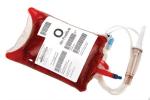|
This section contains 840 words (approx. 3 pages at 300 words per page) |

|
The fluid that carries substances such as hormones, oxygen, and glucose to the tissues of the body and carries carbon dioxide away from the tissues as waste.
Blood is the red-colored fluid that flows through the arteries and veins of the body. Vital to the survival of the body, blood travels through the arteries carrying oxygen from the lungs and glucose from the liver to every cell in the organs and tissues of the body. It returns to the lungs via the network of veins, having exchanged oxygen for carbon dioxide, a waste product. Adults have about sixand-one-half pints (four liters) of blood, which is composed of blood cells (representing slightly less than half of the blood's volume) and plasma.
There are three basic types of blood cells.
- Red blood cells (RBC) contain hemoglobin which carries the oxygen from the lungs. Hemoglobin...
|
This section contains 840 words (approx. 3 pages at 300 words per page) |

|


